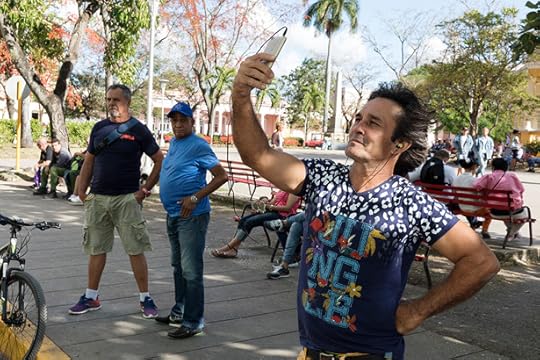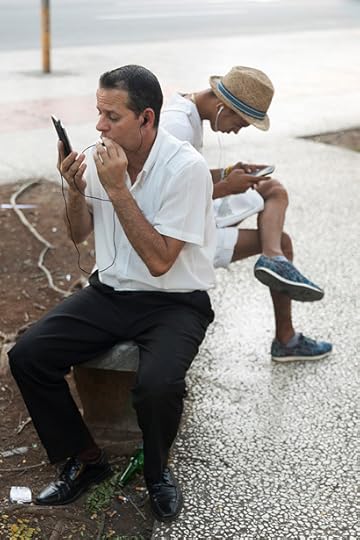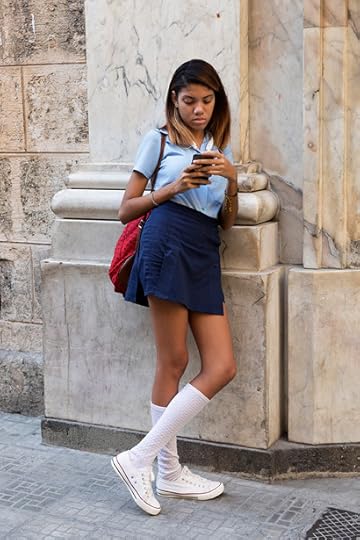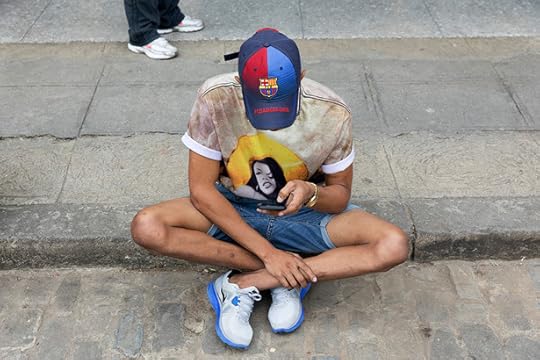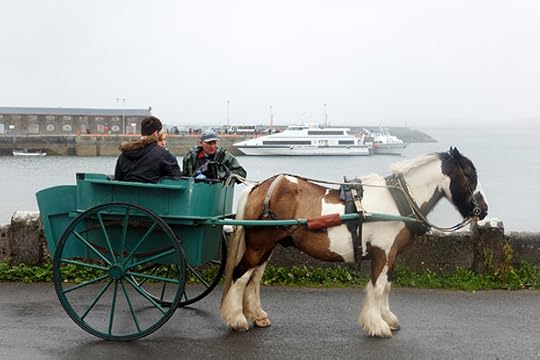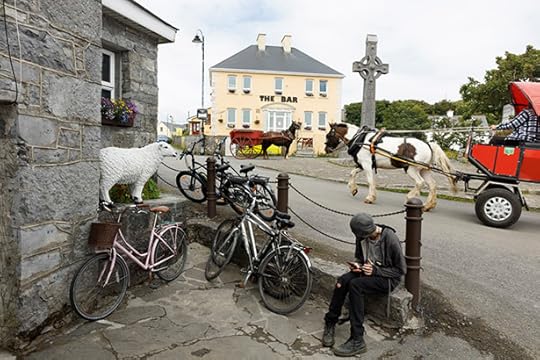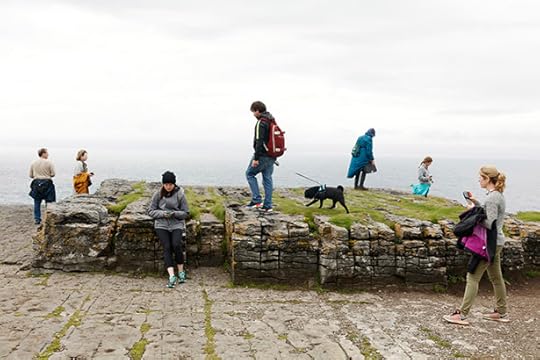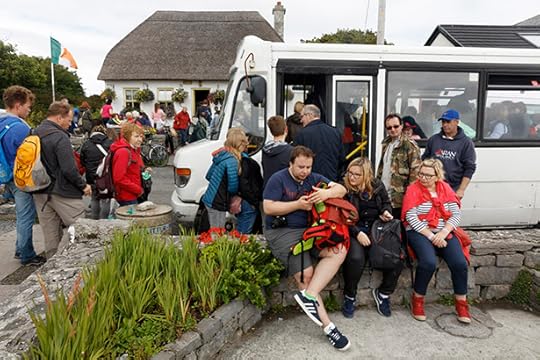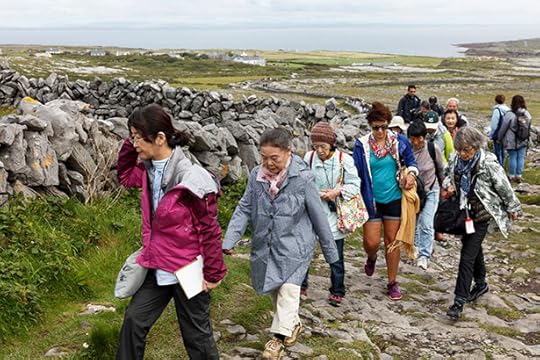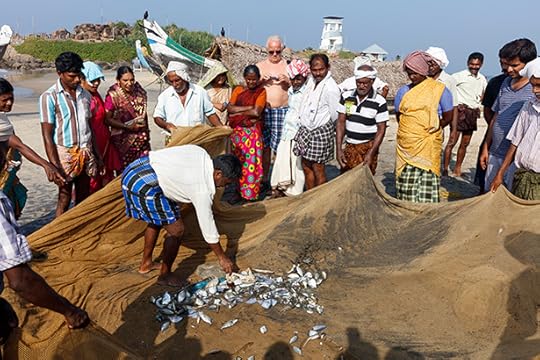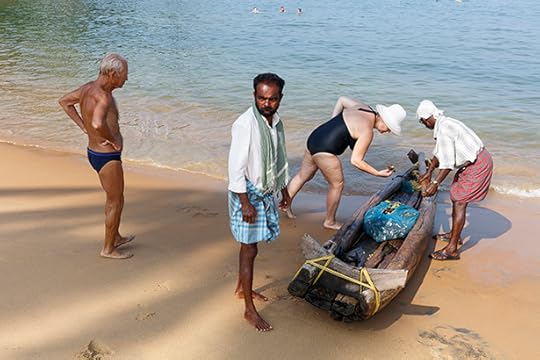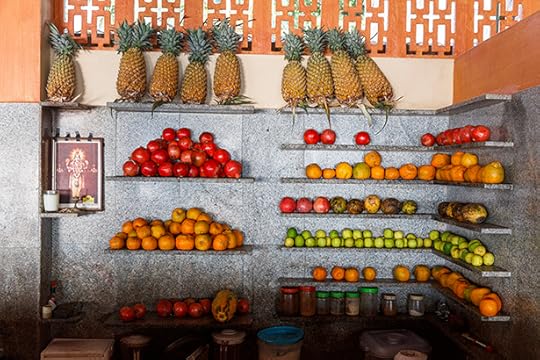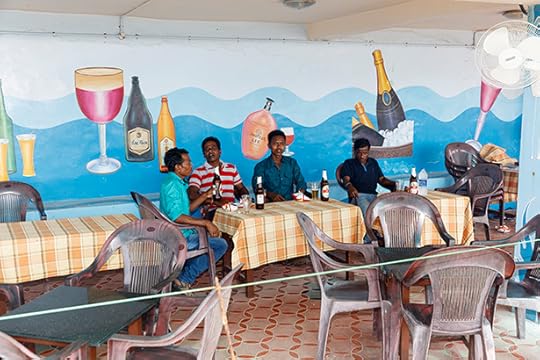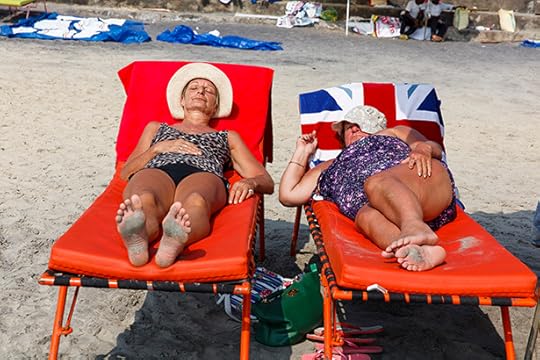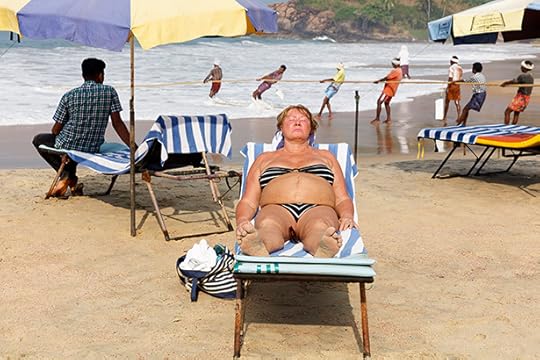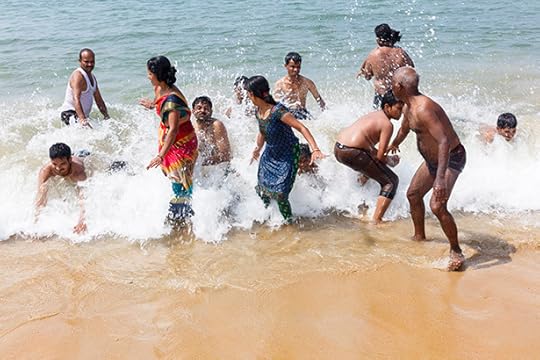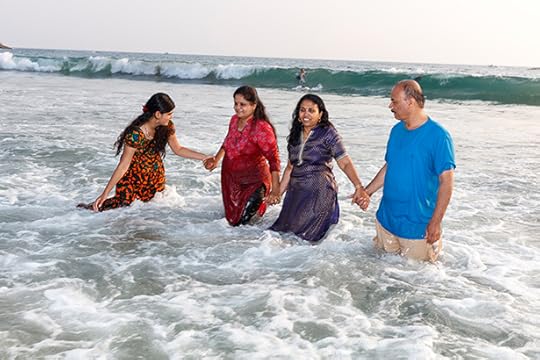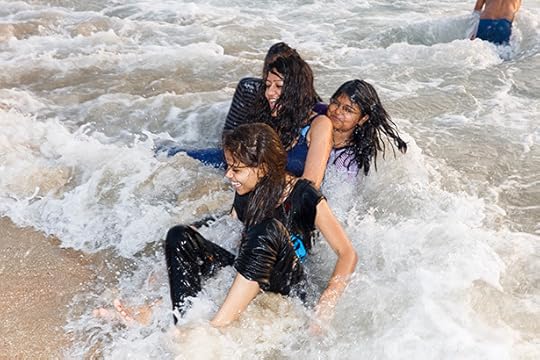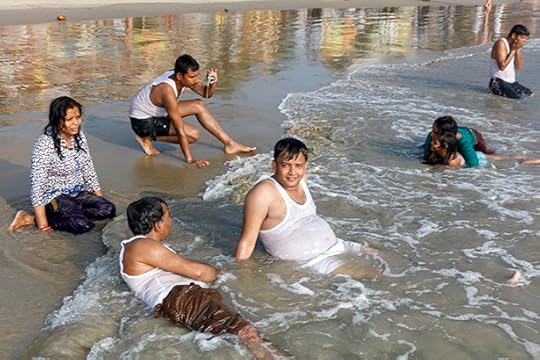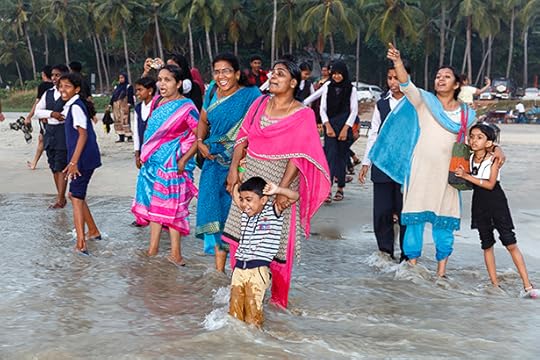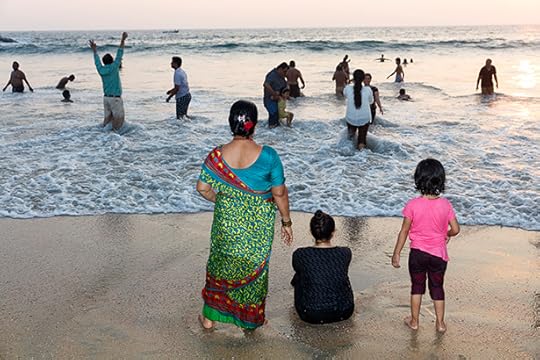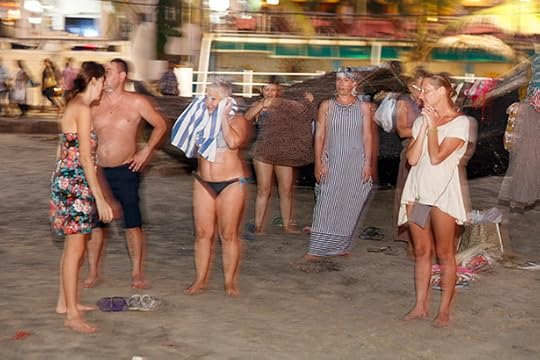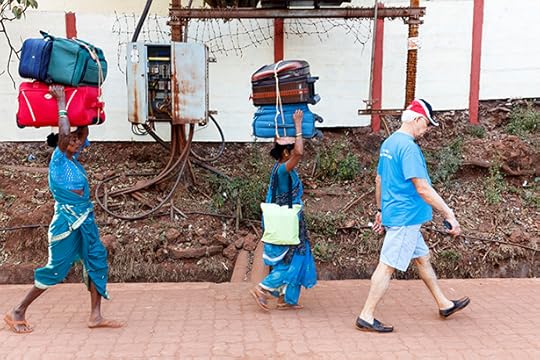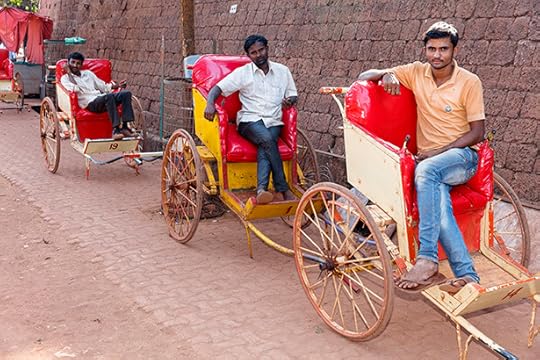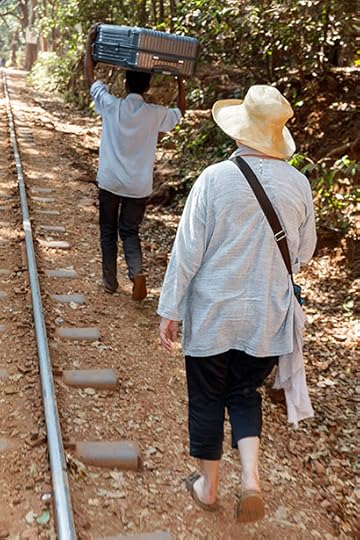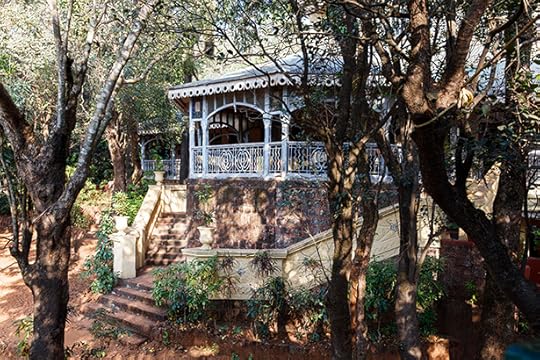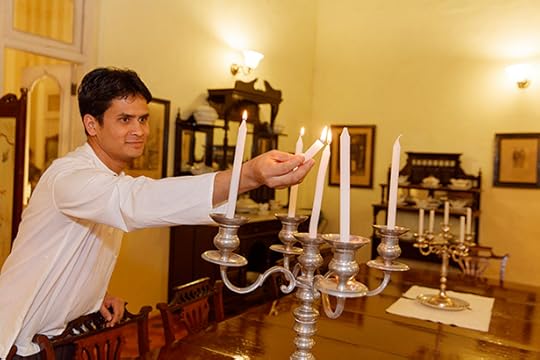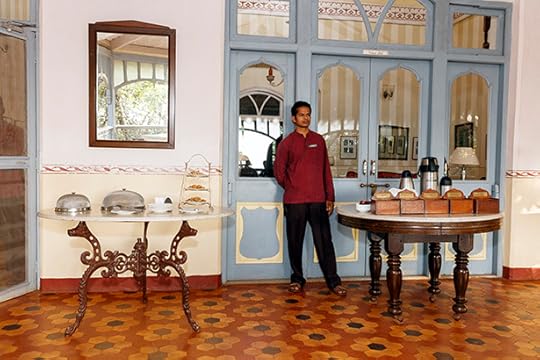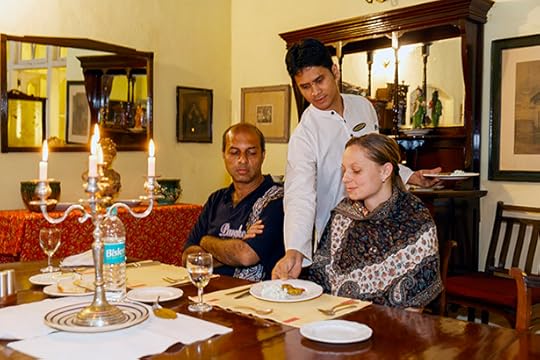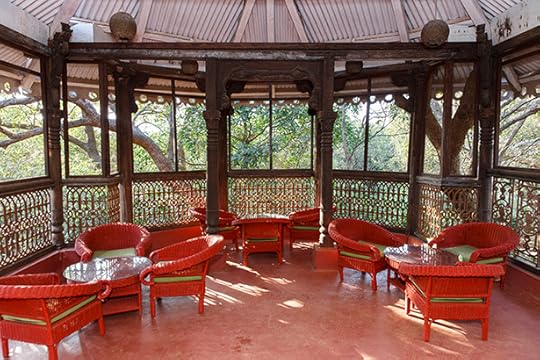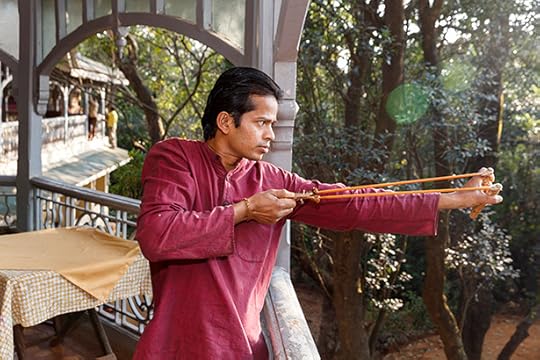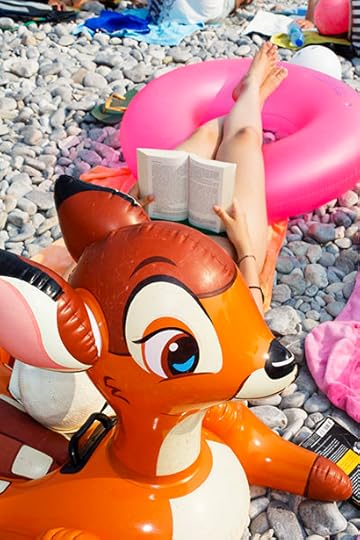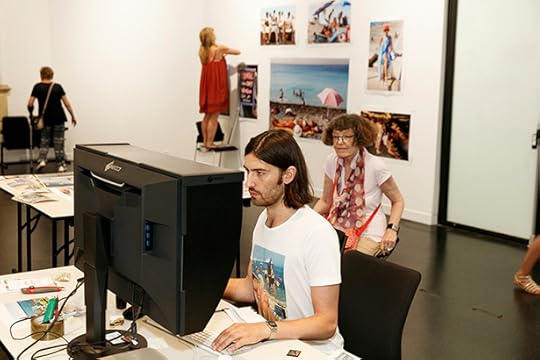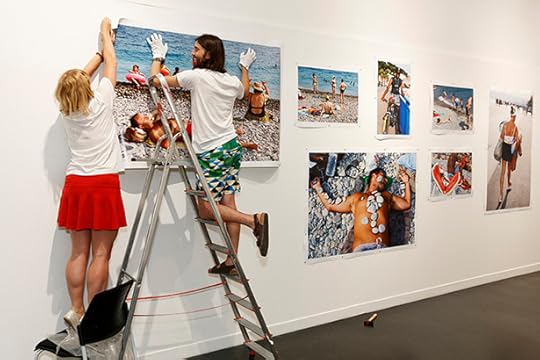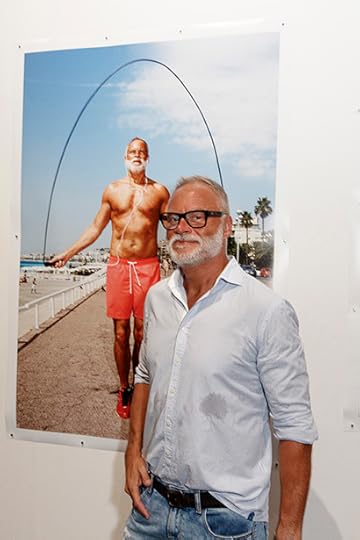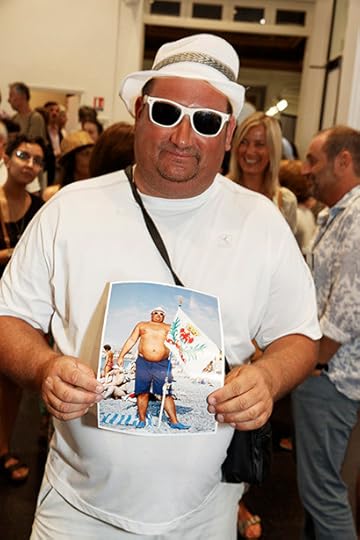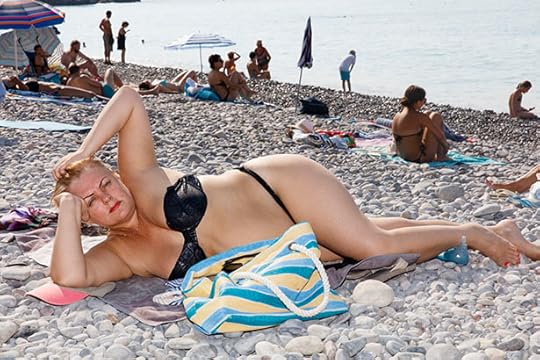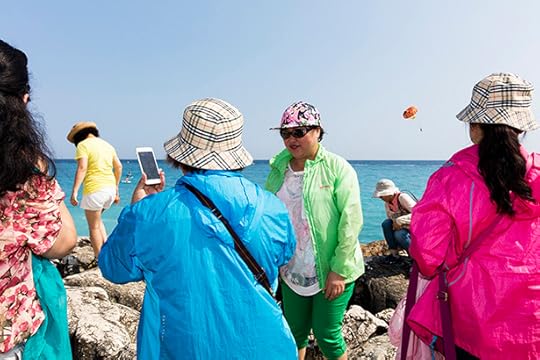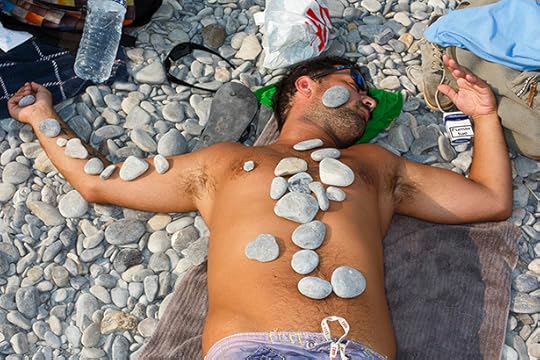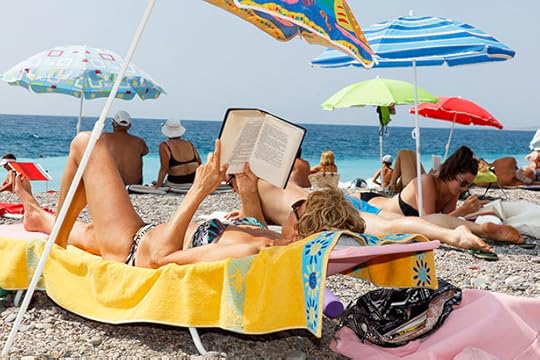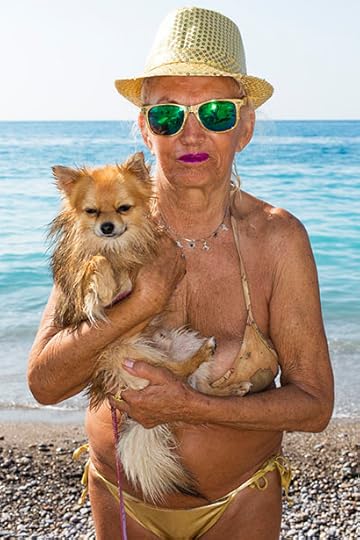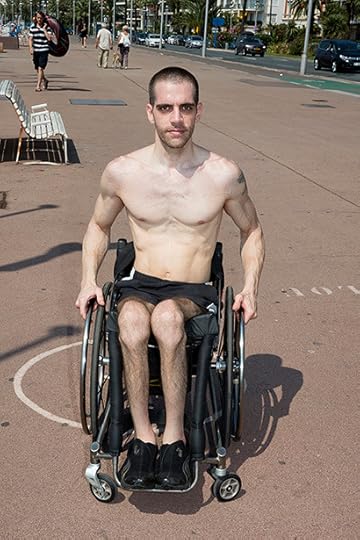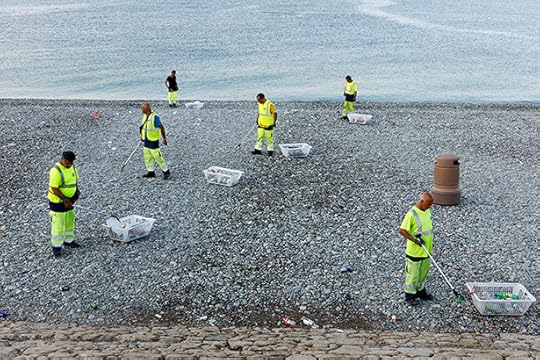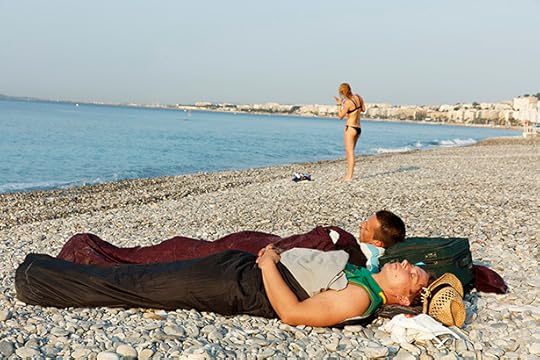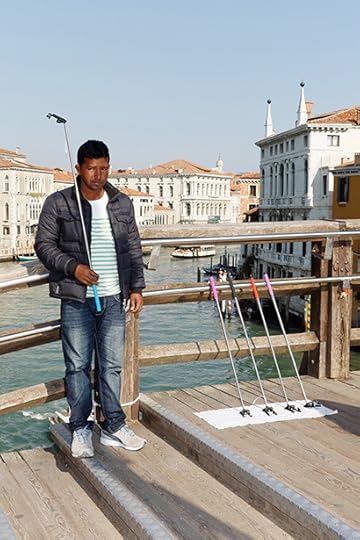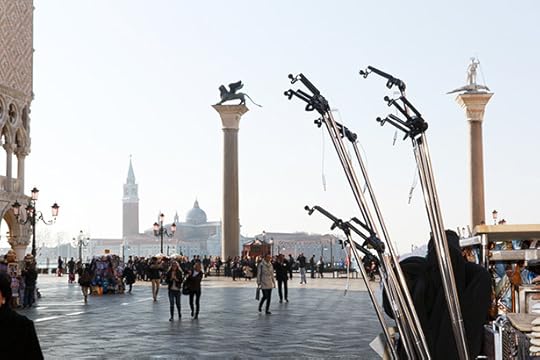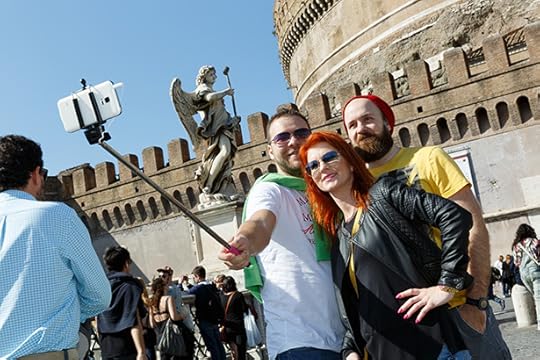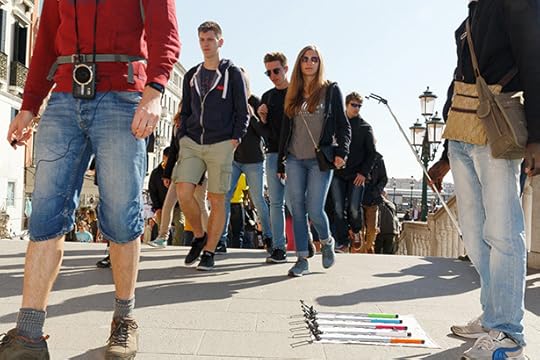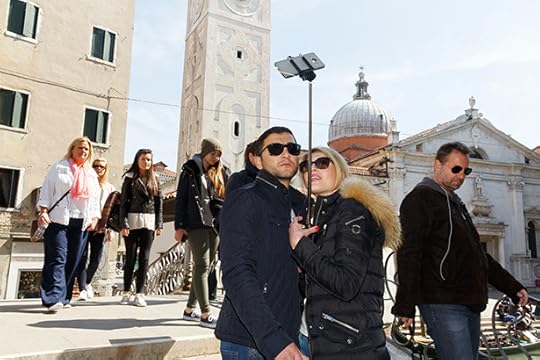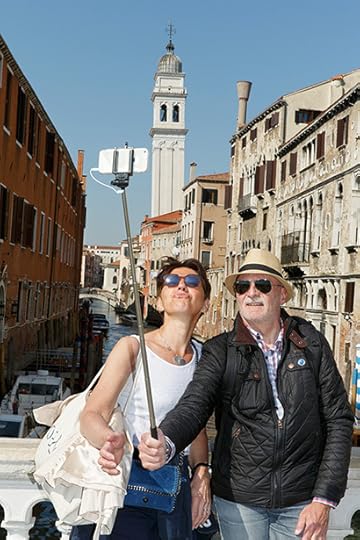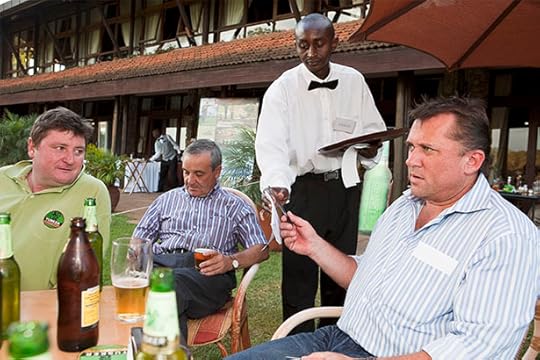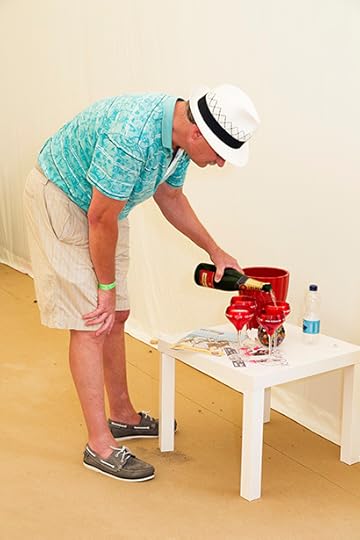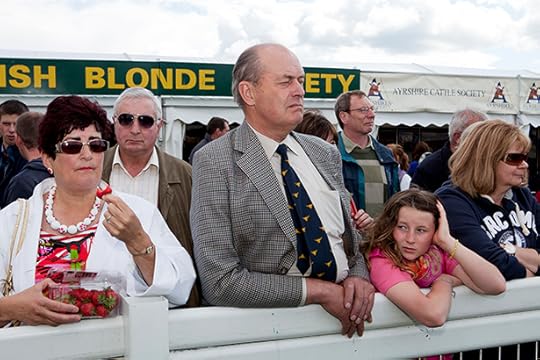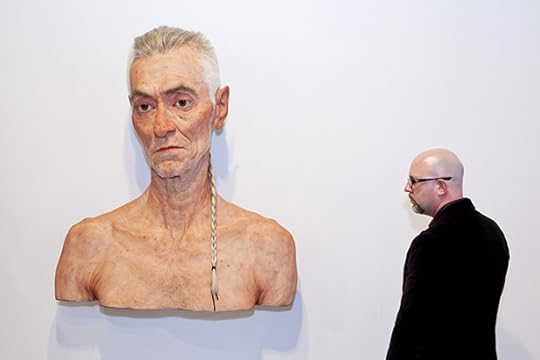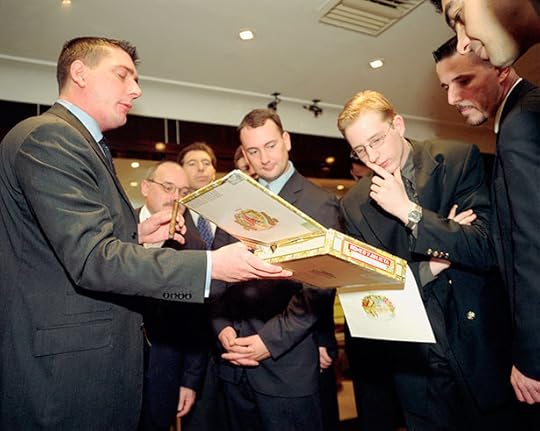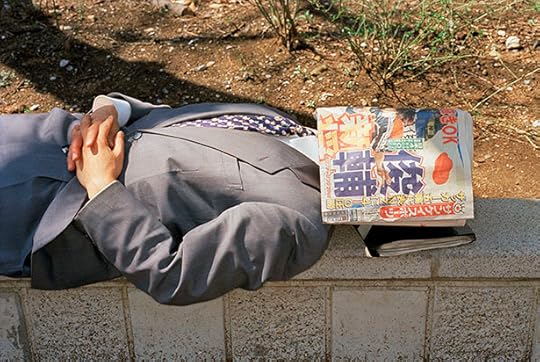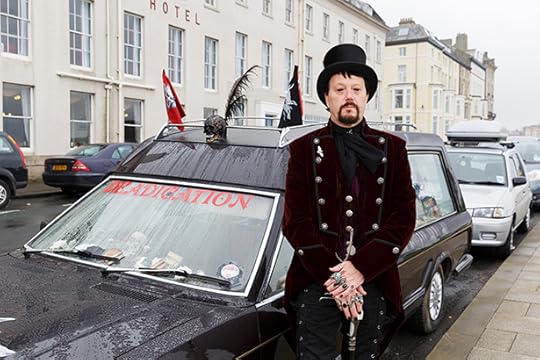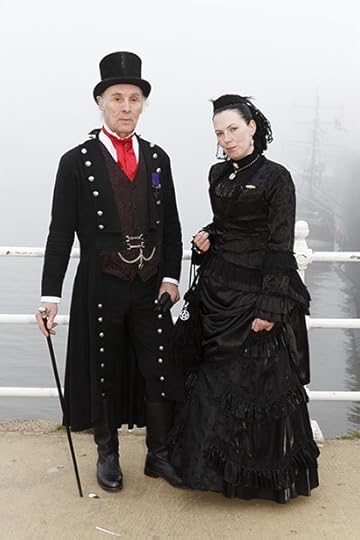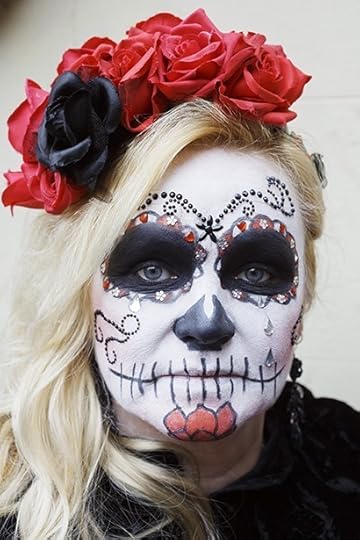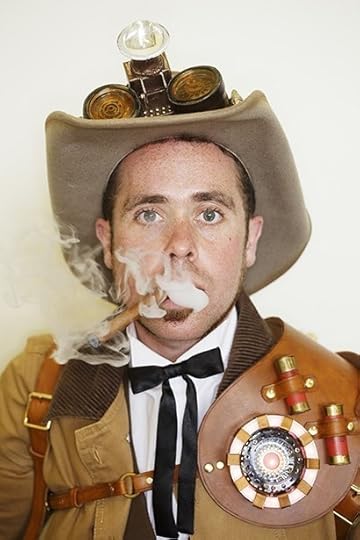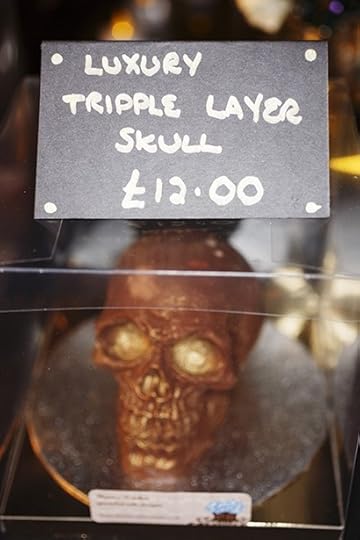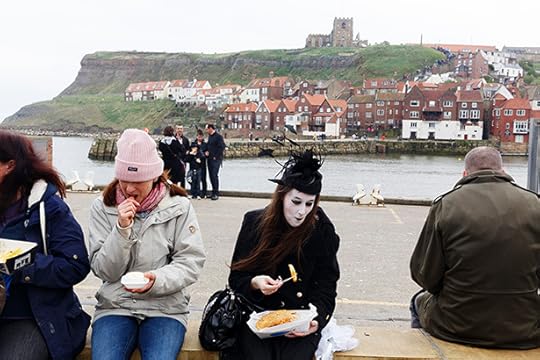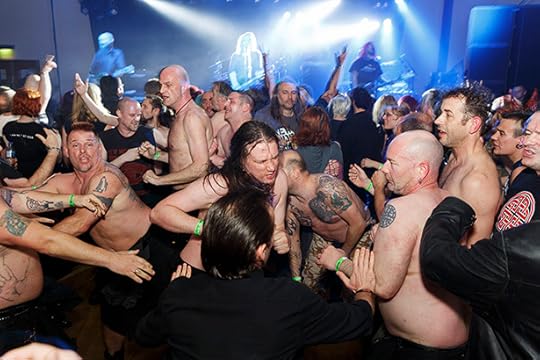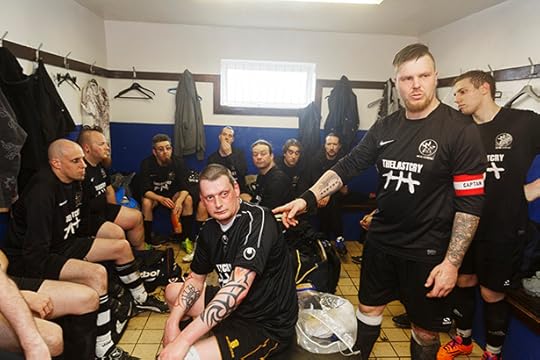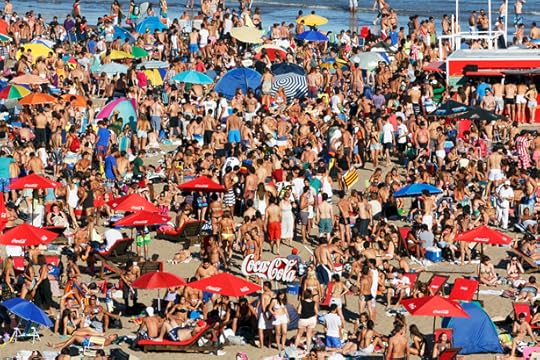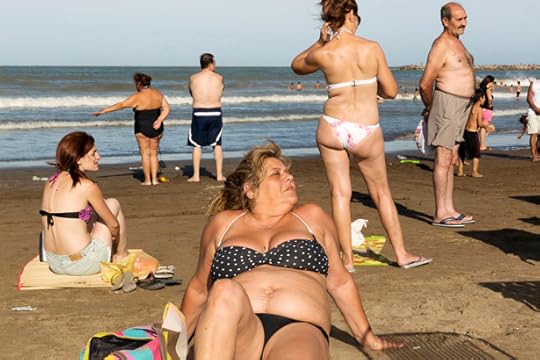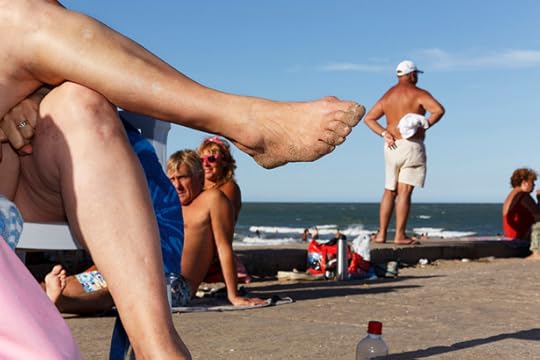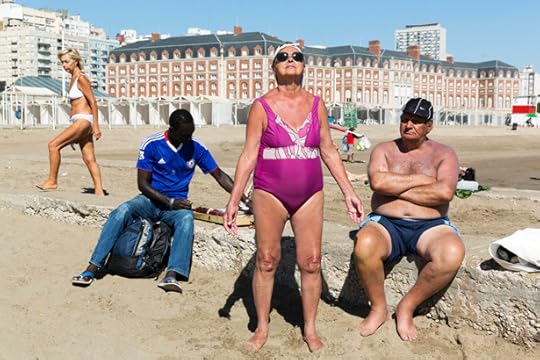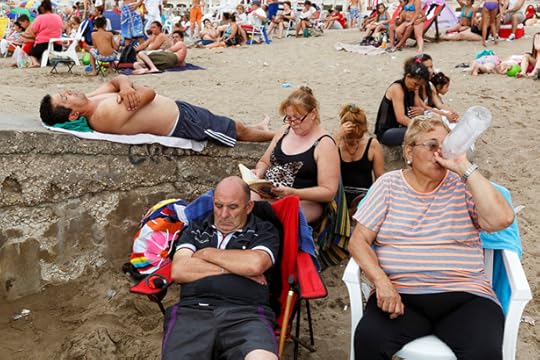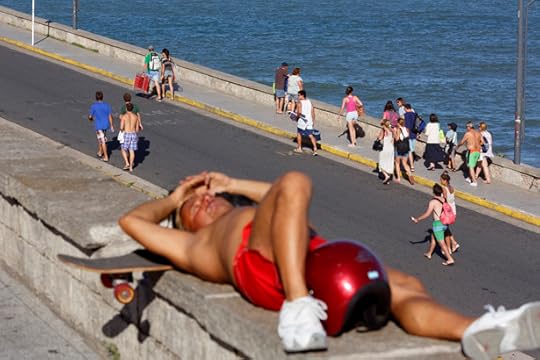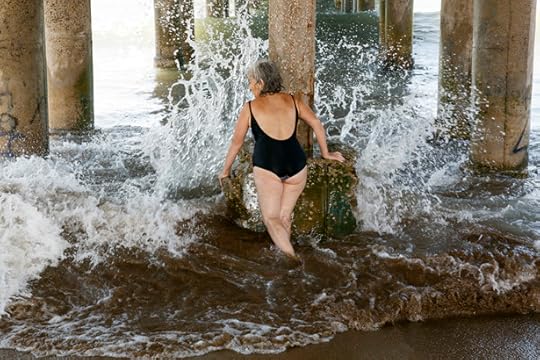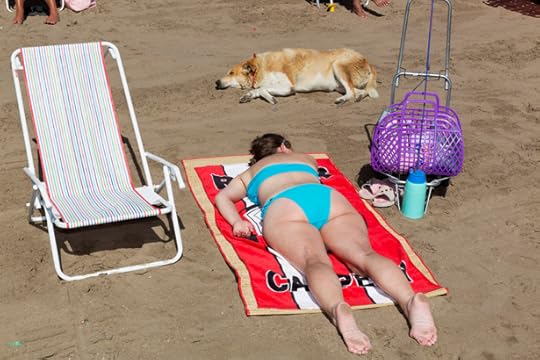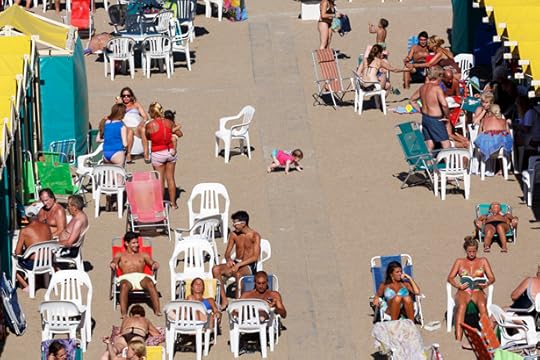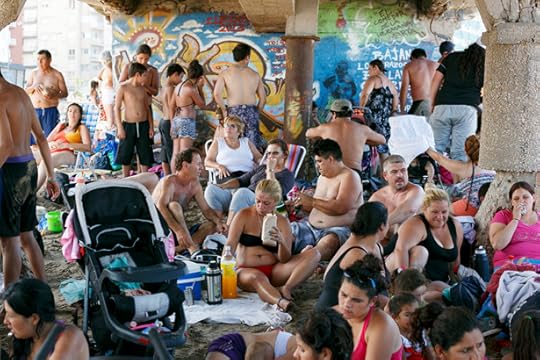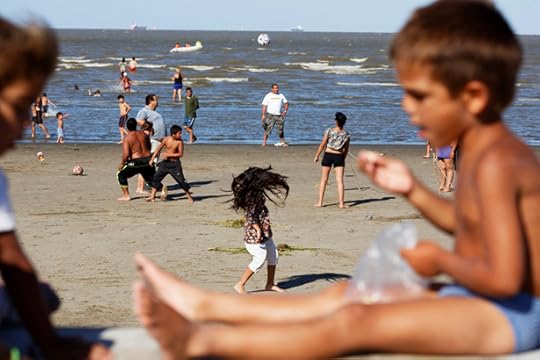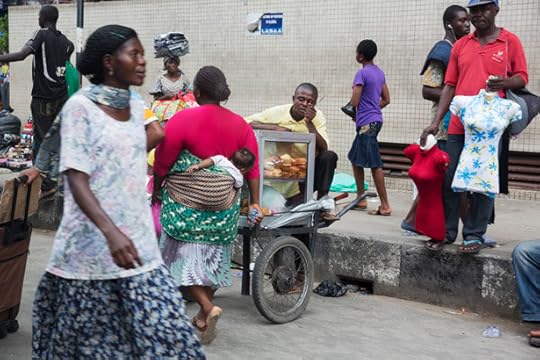Martin Parr's Blog, page 2
March 14, 2017
Cuba on line: the second revolution
Cuba on line: the second revolution
Text by Susie Parr
Sunday, late afternoon in the city of Camaguay, central Cuba. As the dense heat starts to lift, families pile into horse-drawn taxis, squeezing six a-side along the narrow wooden seats. A flick of the whip sets the bony steeds struggling into a trot, turning left onto the main carriageway, dodging Russian-made motorcycles, Ladas roaring along in clouds of black smoke, and the massive Yutong lorries that constantly thunder along the straight, rough road to Santiago. They take a right into a street lined with ramshackle houses, finally coming to a halt at a park called El Lago de Sus Suenos (The Lake of Your Dreams). There is a lake here, where egrets stalk and the evening’s first mosquitoes rise from the swampy mud, but a sign warns that the water is contaminated and swimming is therefore forbidden.
At the gate, a few pesos are exchanged for a paper ticket, ceremoniously torn to mark your entrance. You can wander along the network of paths, lined with concrete benches, past bars and snack outlets towards the park’s central feature: an elderly Cubana jet, its nose lifted, forever stilled at the point of take off.
Families crowd into the pizzeria or take the air, strolling and chatting while the children play and scramble. Young men, clutching cans of Cristal, eye the girls. But their admiring glances and raucous comments can go unnoticed: most of the young are intent on their mobile phones. Using IMO – the Cuban version of Skype or Facetime – they talk at top volume, beaming at the fuzzy image of an aunt or grandma in America or a cousin in Madrid, the person who may have sent them the cell phone in the first place, or given them the money to buy one. Boyfriends are introduced, new babies admired, gossip updated while the old – and unconnected – look on in bemusement, having to make do with the lake and the jet for entertainment.
All over Cuba, in selected parks and on designated street corners, in every city and reasonably sized town, the same scene will be playing out. These are the ‘zonas de wifi’, where Cubans can get on line. As yet, internet access in private houses is unheard of, and – besides – few people own a computer.
Getting on line is not an easy process. First, you must purchase an ETESCA card – which will give you username and password – then find a wifi zone. Once you pick up the signal, you negotiate the on-screen access form, filling in long strings of numbers. The wifi signal is erratic, dramatically strengthening and fading minute by minute. ‘Conectar’ (to connect) is expensive. Cards giving one hour of access cost 2 CUCs (roughly £2), approximately two thirds of the average weekly wage. Cubans are understandably parsimonious with their minutes, quickly checking their Facebook page and keeping IMO conversations brief. Few take the time to surf. Email can be managed through the phone network, which is cheaper and therefore less pressurised.
And the equipment essential for getting on line will cost you dear. Alcatel, Blu and Prime handsets sell for upwards of 120 CUCs -ten months’ wages – while the latest Samsung smartphone will set you back at least 200.
And phones are hard to come by. Cuba’s modest shop fronts display life’s necessities: soap, plastic goods, baby clothes, deodorants, bottles of shampoo. Food shops sell the basics, which are rationed. In such a context, glossy emporia showcasing the latest cellphone models are unthinkable. Those who do sell phones usually have only a few hidden away in a drawer or in a briefcase under the desk. One dealer outlined the circuitous route of acquisition: friends and relatives from the Cuban diaspora send the phones and these are either sold new or distributed amongst the extended family, then cashed in.
Despite all these difficulties, the internet revolution is taking hold in Cuba. It is estimated that around 25% of the Cuban population (mostly younger people) own a mobile phone. Raoul Castro is slowly loosening the grip of the state, for example allowing private restaurants to set up in competition with the grim, government controlled eateries that predominated for decades. The internet is an essential infrastructural resource for business and for tourism- Cuba’s second most important industry. But many question the pace of progress. Why, in a country that has such excellent health care and education, does access continue to be so expensive, so difficult, and so limited? One answer might lie in the official response to the new phenomenon of blogs that comment on Cuban society, some of which are openly critical of the government. These sites may be accessed from outside of Cuba, but from within access may be blocked or monitored.
As darkness falls in Havana, phone screens cast a gentle light onto the faces of the Cuban conectados, standing alongside tourists outside the Ambos Mundos (Both Worlds) bar. Cubans are gazing into a brave new future in which information, acquisition and dissent are open to everyone.
August 6, 2016
Inishmore
Inishmore
Text by Susie Parr
Twenty five years ago, visiting Inishmore – the main Arran island off the west coast of Ireland – you would probably have been wise to prepare yourself for a less than comfortable experience. The ride into rough seas – butting through prevailing south westerlies – would finally deliver you to the old landing point at Kilronan. Emerging queasily from the boat, you would find yourself plunged straight into a feeding frenzy, as pony trap and minibus drivers vied with cycle rental businesses for your custom. If it was raining – as was often the case – you might retreat to the nearest pub or café where the offerings were usually grim: stale white bread, leathery meat, instant coffee, damp crisps, sickly sodas. Not a salad leaf or fresh juice in sight. The one exception in the food department would be the candle-lit vegetarian banquets served, with opera blasting out over the hi-fi, in the hostel run by Joel – an exotic creature blown in from America and long since departed from these rocky shores.
Then the cycle ride on a bike with sagging saddle, squeaky brakes and deficient gears to find your campsite, or the B and B where you would try in vain to dry your clothes by draping them over a cold radiator.
These days, despite the same sickening ride as the boat lurches through the waves, you make landfall at a streamlined new harbour that is free of hagglers. All seems calm as you emerge to wander round the town. The main settlement even boasts a small municipal flower display, although begonias and pot marigolds are no competition for the ox eye daisies, orchids, harebells, scabious and loosestrife that nod in the fields, the rowan trees laden with orange berries, the fiery montbresia and fuchsia that glow from every hedgerow.
There are still some takers for the horse drawn traps, mostly driven by old timers, although one young driver with an asymmetric haircut, sparkling earring, sports gear and mobile phone makes his own statement about modern times on the island. A few visitors opt for the rusty minibuses that rattle along potholed lanes on a speedy tour of the island’s prime sites. These are outclassed by the Mercedes people-carriers that now guarantee a comfortable ride, with air con if required.
It’s unusual to see an Irish tourist here: Arran’s thousands of day-trippers hail from France, Germany, Spain, Italy, America and Japan. And the island has upped its game to meet the expectations of these cosmopolitans.
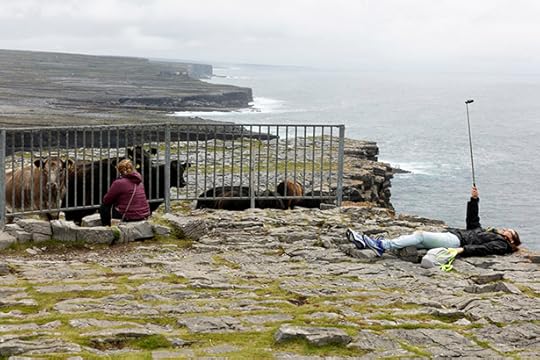
At the ancient fort of Dun Aengus you now pay 4 euro for multi-lingual interpretation boards, toilets and a signposted pathway leading up the wild, rocky cliffs. The hire bikes are sleek and many-geared, with helmets provided. You can buy designer knitwear and subtle silver jewellery. Cafes serve cappuccino, ciabatta, salad leaves, Arran feta cheese and mackerel pate with fresh soda bread. The only thing that hasn’t really changed is the Guinness: cold, black, slowly poured.
March 23, 2016
Kovalam Beach
Kovalam Beach
Text by Susie Parr
In the early morning, a few elderly Westerners enter the sea where it is relatively calm, protected by a rocky outcrop. Later, this spot will become the launching place for the speed boats and therefore out of bounds for swimming. Floating in the swell, the bathers look down the beach. No-one is in the water just a few yards along, because the unhindered waves are so powerful, and the undertow so strong.
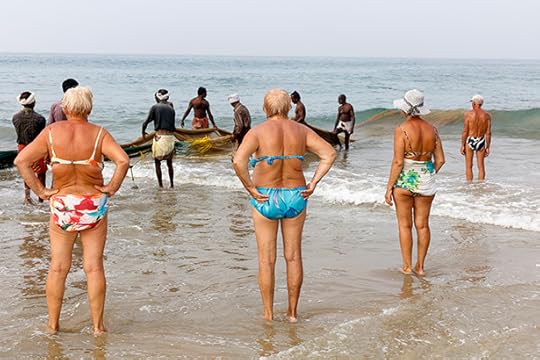
Aside from one or two early sun-worshippers, already spread-eagled on their loungers, the only other people on the beach are the fishermen, hauling in the nets dropped from their boats some hours before. Around fifteen men pull on each side, slowly bringing the catch nearer. The men heave and chant in a rhythm, their efforts more effective when all work together. The white floats on the nets gradually approach. As the haul is finally dragged onto the beach, they huddle around to examine their catch. But it is meagre: roughly 3 kilos of small fish and flounders, barely 500 rupees’ worth for the hours of work and effort. Grumbling, the men turn away, eyeing the few tourists who are watching, photographing the scene. One, who speaks English, asks the spectators for cash to compensate for this sorry turn of events.
The seas have been so over-fished that poor catches like this are sadly becoming commonplace. No doubt within a few seasons the men will enact these ancient rituals purely for the benefit of tourists. They will become like the Chinese fishermen in Fort Kochi who lower their nets into the polluted water as a photo opportunity: more lucrative than trying to catch and sell fish.
As the morning unfolds, more Westerners start to emerge from their hotels and apartments, into the stupefying heat. They wander slowly past the cafes and stalls selling knick knacks, sarongs, sun hats and pashminas, either ignoring or patiently declining the invitations that accompany their progress. ‘Good morning! You want tea, coffee, juice, sandwich?’ ‘Mango, pineapple, banana?’ ‘I am a tailor. I make these myself. Good price.’ ‘ Special nut, sir?’
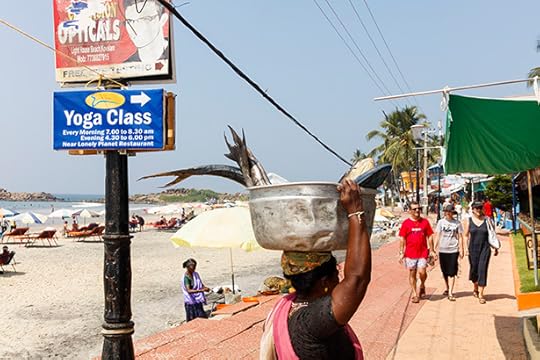
Kovalam’s shop owners, waiters, beach vendors, tuk tuk drivers and sun-bed proprietors seem eternally optimistic, refusing to be deterred by a shake of the head or patent lack of interest in their offers. ‘Maybe later madam?’ ‘What time you going back?’ ‘How many days in Kovalam?’ ‘ Maybe later you want to buy a lamp?’ ‘Later for a nice lunch?’
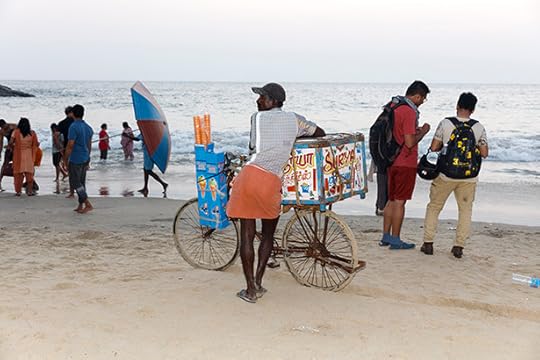
They can seem predatory, particularly those who relentlessly hassle their victims, persisting in touting wares or snacks that have been refused countless times, but here on the beach there is still an underlying sense of good will, courtesy and humour. Waiters and shopkeepers are friendly, liking to chat and share a joke. They are helpful to the older, frailer visitors, and kind to the young. The man who rented me a sun-bed took care to adjust the umbrella periodically as the day wore on, so that I could be in constant shade. When I expressed my concern about the force of the waves, he smiled and promised me the water would be still as a pond the next day, but only if I came back to his patch. I did, for he was charming, but of course the waves were even more mountainous and the undercurrent more intimidating.
This is not a particular problem if you can swim, although giant waves can arrive unexpectedly, catching you unawares, spinning you head over heels under the surface, tugging your footing from beneath you. Two lifeguards, clad in light blue uniforms, patrol each beach, keeping close eye on the colour of the water. If this changes, it suggests that the sand is being whipped up by dangerous undercurrents. The lifeguards direct bathers away from these trouble spots, blowing whistles and waving red flags, as if despatching a train.
The lifeguards put in extra effort when groups of Indian bathers enter the water. Predominantly men, youths and boys, most seem unable to swim. Holding hands, egging each other on, they wade towards the place where the waves break. As the water crashes over their heads and spins them so they bob like corks in the foam, they roar with delight. Swimming trunks are a rarity- most of the men enter the water in their underwear.
As more and more men and boys pile into the surf, the lifeguards change from railway guards to traffic police, blowing their whistles loudly to get attention and using vigorous hand signals to direct the groups to one side or the other, or beckon reckless dippers into shallower water.
Mostly, Indian women bathers are much more cautious, tucking up their saris and kurtas or rolling up their jeans to paddle at the water’s edge. Small groups of women venture into deeper water, ducking down as if to take a bath, and soon they are completely soaked. They scream with excitement as they are knocked over by the waves or lifted on the swell. One woman, spotting a shoal of fish swimming in the shallows, uses her sari to net a tiddler.
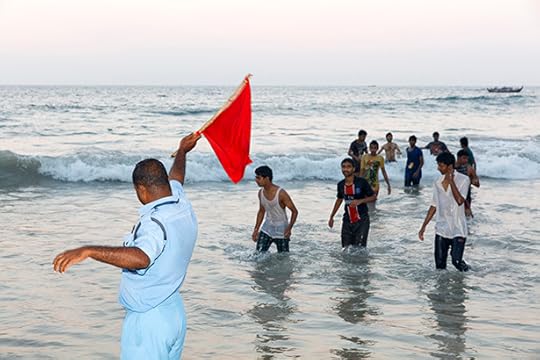
The lifeguard says it is rare to see an Indian visitor actually swimming; those who do swim probably come from Delhi, where they have learned in a pool. Women, he explains, need to keep to shallow water, where their husbands can keep an eye on them.
Most Indian visitors tend to arrive later in the day; they stroll along the beach, gazing with benign curiosity at the spectacle of the Westerners broiling in the sun. Young women, clad in skimpy bikinis, attract sly looks and jokey comments. This is not entirely surprising, given the modesty and elegance of their Indian counterparts, none of whom don bathing costumes. Indeed Westerners of all ages, sizes and shapes think nothing of exposing their often ample flesh, leaving little to the imagination.
The skinny ones on the beach are the fishermen, the vendors and the yoga students, who emerge from their morning session in a trance-like state, some walking serenely along at the water’s edge, some sitting cross legged on the beach in full meditation mode. For lunch they sip water and toy with a salad, eschewing the cold beer, chicken tikka and chips favoured by their compatriots.
On Sundays, Indian visitors outnumber the Westerners, who look on bemused as scores of men and boys enter the water or stroll along the sand in huge groups. The vendors selling tea and coffee, and ice cream, both wheeling their wares on heavily laden bikes, do a good trade. Men wander along with their arms around each other’s shoulders, or their hands loosely linked; not lovers, but brothers, cousins, fathers, sons, uncles, nephews and friends.
Two small boys are absorbed in constructing an elaborate sand castle, complete with moat, bridges and castellations. They have brought their own bucket, spade and plastic moulds from England; sand castles are not part of Indian beach culture, as evidenced by the number of men who stop to admire their work, and take photos. The boys dig on, oblivious to their appreciative audience, occasionally running to the water’s edge to fill the bucket and return it to the moat.
As the sun moves towards the horizon, foreigners repair to the bars and cafes while more Indian groups and families appear on the sand, promenading in the cooler air of late afternoon. Indians are passionate about watching the sun set, and seize any opportunity to snap selfies or set up family portraits against the romantic, reddening sky. Some men cannot resist taking a final dip, even though the lifeguards are ordering everyone out as their shift comes to an end. Most people comply, reluctantly obeying the vigorous whistle blowing and flag waving. Some Westerners, predominantly hippies and yogis, ignore orders, refusing to curtail their sunset swim. The fishermen heave in their afternoon catch, and thankfully it is marginally larger than the morning haul.
Darkness falls, and Kovalam lights up. Displays of fish and seafood appear outside each restaurant: marlin, sea salmon, grouper, prawns and crab.
Out at sea, lights appear on the wooden boats, where men sit through the night, hoping the fish will come.
Matheran
Matheran
Text by Susie Parr
On a Sunday morning, the car park for Matheran is crammed with haphazardly parked vehicles abandoned on Friday by the weekenders from Mumbai and Pune, 90 km and 120 km away respectively. As you arrive, a crowd of ragged men surrounds your vehicle, each one entreating the driver for the privilege of carrying your luggage up into town. The befuddled tourist watches aghast as the skinny victors in this bidding war heave large, heavy suitcases onto their heads and lead the way up the rocky path towards what one person described as ‘the city centre’.
Walking along behind the bearers, mixed feelings combine a deep-seated colonial shame, profound embarrassment, and anxiety about the state of the men’s vertebrae. These concerns are partially allayed seeing Indian tourists strolling in a care-free fashion behind their own coolies.
Because motorised vehicles are banned in Matheran, India’s smallest and only pedestrianised hill station, there are only four means of getting from the car park into town. You can walk; you can be pulled along in a rickety handcart that looks like it has been around since pre-Independence days; you can take a ride on a skittish horse, or you can catch the toy train, pushed up the narrow gauge track by a roaring diesel engine. Given the train’s erratic timetable and the scores of passengers squabbling over seat allocations, walking seems like the most attractive option and at 840 meters above sea level, the air is relatively cool and pleasant. It takes about thirty minutes to reach the town, walking along or beside the train track, through a thick evergreen forest where monkeys leap, chipmunks scamper and exotic birds warble and whistle.
You’d think that the total lack of traffic and the close, intense presence of the natural world would make for a peaceful stroll, away at last from the incessant horn sounding, the thunder of lorries, the buzz of motor scooters and the polluted air that hangs in a poisonous haze over the cities. But along the path, the air is clogged with the red dust kicked up by pedestrians and ponies, and thick with the smell of manure. Cries of ‘Side!’ interrupt any reverie as bearers trundle people, luggage and goods along in the handcarts.
As bands of horses charge along the path, their handlers bawl and haggle, and one is repeatedly invited to give this form of transport a try. Walking along sedately behind your suitcases, you quickly learn that a polite ‘No thank you’ while avoiding eye contact is the best way to counter the constant litany of offers: ‘Handcart, Madam?’ ‘You try horse sir?’
But other visitors to Matheran provide by far the noisiest accompaniment to the walk. Gangs of young men shout jokes back and forth, clutches of young women shriek and giggle, and extended family groups exchange banter and laughter, all at full volume. With its basic hotels and rest homes for railway employees and other workers, Matheran is predominantly a resort for the lower middle classes. Air conditioning has made the hill station almost obsolete as an escape from the heat for the rich and elite.
Westerners are rare, as evidenced by the curious stares and muffled giggles elicited as you pass by. Some of the braver visitors try out their English: ‘Hello Aunty! Where are you from? You like India? What is your name?’ Each equipped with their own smart phone, groups of teenagers egg each other on. They can become quite bold, asking to take your photo or for you to join them in a selfie. Once one selfie is taken, everyone else has to have one, until you finally excuse yourself and break away from the group, as they collapse in laughter.
The main drag through Matheran is lined with stalls, cafes and shops selling chikki (a local delicacy), cakes, snacks, soft drinks, chai, thali, tattoos, kulfi, handicrafts and hats. There is a tired looking post office with a corrugated iron roof. On either side of the road, hotels and holiday homes rise up, some fairly modern but others housed in buildings that are over one hundred years old, erected by the British seeking respite from the heat of the plains. The Hermitage, the Woodland, the Regent, Cecil House, Lord’s Hotel and scores of other establishments offer ‘spacious, comfortable, clean accommodation, disco, playground, reasonable rates’. Some even boast pools, although no-one is swimming. The Verandah in the Forest lies two kilometers beyond the town. The path to the hotel also leads to Cecil Point, a spectacular place to view the sunset, so there is plenty of equine and human traffic to dodge. Nevertheless, as the town gives way to forest there is a growing sense of what Matheran must have been like at the turn of the last century – a place where the well-to-do could take their ease within a like-minded community, a secluded environment, and a comfortably temperate climate. On either side of the path, once-grand gateways are in a state of collapse, once well-maintained drives wind into the jungle scrub. Sometimes, looking into the forest, you can catch a glimpse of what were once fine old buildings, now sagging into the ground, grey and neglected, beyond the scope of even the most ambitious and optimistic developer. At some point, these delapidated dwellings may be demolished to make room for one of the new hotels that are springing up across the resort. Hopefully they will not share the fate of the erstwhile Matheran Club. Still marked on the town map, the clearing where it once stood now functions as the local rubbish tip, where goats, monkeys and feral dogs pick through the town’s detritus.
Faded colour photos displayed on the lower terrace of the Verandah in the Forest show the house being restored, suggesting that it only narrowly escaped the fate of its immediate neighbours.
Built in the last decade of the 19th century by Captain Barr (and known locally as Barr House) the building retains many fine original features, in particular two magnificent tiled verandahs, the upper one with an elaborate corrugated iron roof, stained glass windows and wooden fretwork. There is an elegant sitting room with a high, vaulted ceiling and decorative plasterwork. In the garden, a look-out snug accessed by ladder allows guests to sit and chat within the tree canopy.
If the website and the fact that the establishment is part of the Neemrana chain lead you to expect a Western hotel experience, think again. The hotel is charmingly faded with few of the mod cons one might be used to: there is no internet, no phone signal, no television, no air conditioning. The paintwork flakes and the wiring is alarmingly primitive: wires are frayed and plugs spark as you insert them into the sockets. Below the house lies a tennis court that has gone completely to seed. The bathrooms are functional, the rooms plain. By modern Western standards, it does not feel luxurious. But the original pieces that furnish every room bear witness to the fact that Barr House was once the epitome of Edwardian style and comfort. Stolid wardrobes, chests of drawers, rosewood four posters with tiled inlay, daybeds, verandah chairs, washstands, dressers, desks, sofas, chandeliers, mirrors, paintings, rugs, vases, a slowly ticking clock. The prime piece must be the 12 section dining table, where candelabras gleam. One can only imagine that gatherings and conversations that it has witnessed.
Arriving at the Verandah, your shoes and feet caked in red dust, the ceiling fans whirr as you are greeted with a refreshing lemon and ginger drink and asked to sign the enormous battered ledger. The hotel serves excellent food, cooked by the in house chef, but is unlicensed, a fact that doesn’t seem to bother the guests one bit. Although the shouts from the parties visiting nearby Cecil Point carry up to the Verandah, there is deep silence here, particularly at night. The atmosphere is calm, almost soporific, as the gentle rituals of hotel life unfold. Breakfast, lunch, afternoon tea and candlelit dinner – all run to a regular timetable.
This may be one reason why the hotel is troubled with monkeys. The animals know that delicious fruits and breads will be available on the verandah shortly after the sun comes up, and that cakes and sweet snacks will be served between 5 and 6pm, just before the sun goes down. They arrive in groups, leaping from branch to branch, scuttling across the corrugated iron roof. They watch carefully, and if they spy an abandoned plate, the owner having gone in search of another titbit, the bravest will leap onto the verandah and grab whatever they can, hissing and snarling at any attempt to drive them off.
But the Verandah staff are more than a match for the mischief makers. They spring to life, grabbing the leather catapults that lie about on the terrace tables. They take careful aim and let fly a hail of stones at the interlopers. The monkeys beat a swift retreat and regroup at a distance, watching carefully for any lapses of attention, their signal to strike again.
Leaving the Verandah in the early morning, Matheran seems like a different place. The shutters are still down on the shops and cafes, the horses tethered under trees, and only the locals are out and about. Dogs lie curled together on sacks, deeply asleep. Monkeys congregate outside stalls and eating places, waiting for a chance to grab a tasty snack, or steal a carton of juice. The air is cool. Everyone is awaiting the arrival of the next batch of tourists and day-trippers, and here they come, stretching after their long drive, climbing up the path from the car park, through the red dust.
July 16, 2015
A Nice pop up show
It’s the morning after the opening of the pop up show at Nice’s Théâtre de la Photographie et de l’Image. Over the past three to four days I have been photographing the beach, the promenaders and anything that caught my eye along the seven km stretch of the iconic Promenade des Anglais.
During this project, my team from London were processing files, making prints and hanging the show, all in front of a stream of visitors who could watch the whole process. Twice a day I would return to base, download the recently shot images and – after an edit – pass on the next batch of images to be printed.
The show was constantly changing. New photos were added and some taken down. The final version of the show was ready 60 minutes before the opening.
Many of the visitors to the show yesterday had come to see the photos of themselves on display and we invited them to take away a small print of their own image. We also had the smaller prints of wider edits on the tables so these could be viewed as well. I have never attended an opening with so many people squeezed in and with such an enthusiastic crowd.
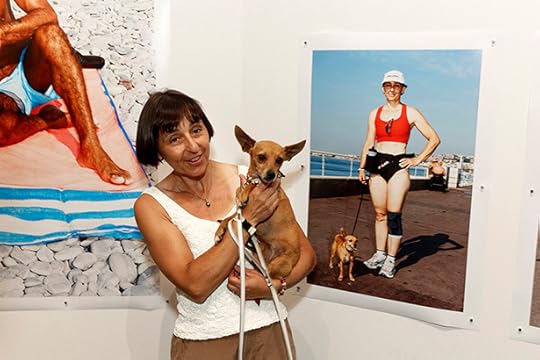
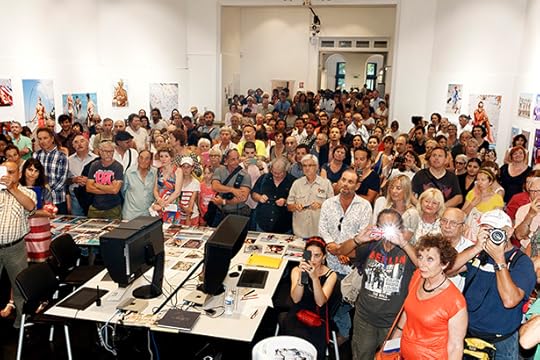
Nice is a very cosmopolitan city and I wanted to illustrate this heady mix in the show. The Russians have their own section of beach. The local Nicoise folk also have their own stretch, where – particularly in the morning – they congregate for an early dip before the crowds descend. The Japanese are noticeable for their umbrellas and sunhats, and then there is an ever increasing number of the Chinese tourists: a new and very welcome addition to the tourist population. There is a full complement of Northern Europeans, Scandinavians, Germans and of course the English, who love to come for the guaranteed sunshine and to escape their own unreliable summers.
Most of all, the locals frequent the actual promenade – early morning joggers, late night dog walkers, sunbathers and swimmers off to find their respective beach section. I stopped many of the strollers and did their portrait, and invited them to the opening.
Life on Nice’s stony beach doesn’t just stop when the sun goes down. In the evening, especially after darkness falls, it seems almost busier than during the day. Many groups, predominantly young people, gather to drink, eat, listen to music and swim in the warm sea. Come the small hours, these groups start to thin out, but then it is the turn of the High Club – just past the magnificent Le Negresco Hotel – to be packed out.
Every morning, by 7am, the army of beach cleaners from the City are in full swing as they pick up the debris from the night before (mainly bottles). These workers appear in force and have to navigate their way round the many sleeping people who have curled up in a sleeping bag or just expired with too much drink.
By 7am, the very early dippers are also starting to show. Groups, mainly of older people, meet regularly: same time, same place, day in, day out.
Les Promenade des Anglais now has a UNESCO-backed preservation order, but ultimately it is the people that make up this complex and inter connected community. My attempt to unravel this was hugely enjoyable, and the pop up exhibition was a great way to share my findings.
May 19, 2015
The Selfie Stick
You have to hand it the guys in the street outside the main tourist attractions. They always sell what the latest craze is, and do so with great aplomb and persistence. Over the years, the goods for sale change as items come in and out of fashion. I recall laser lights, dancing dolls and dogs, and of course the ubiquitous fake designer bags.
All except the bags and sunglasses have now been ditched in favour of the selfie stick: the must-have accessory for the modern day tourist experience.
This trend is quite new. When I was in Rome last summer there were few on the ground. Now they punctuate the skyline. The only time when they are ditched is when it starts raining, The selfie sticks are put away and out come the shit umbrellas and brightly coloured ponchos.
Although many museums have now banned the selfie stick, outside in the street, especially in front of that iconic monument or landmark the stick comes into its own. Getting the photo of you and your loved one(s) with the landmark in the background is de riguer. The tourism industry, which is the biggest in the world, now dictates that the first requirement of any trip is to prove you were there with the necessary photo. It connects you to the world that we know and understand, and is a vital part of any successful holiday experience. We used to have to ask a passing tourist to take the photo, but thanks to the selfie stick those days are over and we are now self sufficient.
What happens with this huge archive of self-expression and proof of visitation is anyone’s guess. Images get posted onto Facebook, or tweeted or Instagrammed and then probably forgotten. They certainly don’t make the family album; that genre has long since died.
I am writing this from Venice where every day there must be millions of self-portraits taken and an equal number of generic photos of this film set city. The only problem is waiting for the gap in the tourist traffic to ensure other people don’t block your view, or get into your photo.
Anyway, I welcome this trend as, interestingly, you can get the whole scene in front of the camera and the backdrop all in one photo. Previously I had to make to do with photos of people from behind as they looked at the view.
November 5, 2014
Suited and booted
Suited and booted: Martin Parr’s chronicles of the Great White Male
First published in the New Statesman, October 2014, guest edited by Grayson Perry
Martin Parr’s vision is simultaneously a celebration of the nuances of tribal behaviour and a gimlet-eyed stab at pretension and earnestness.
When I first encountered Martin Parr’s work in the 1980s I felt I had found an artist who articulated something about being British that I had never seen before, at once affectionate and teasing. I adored his cheeky records of dying working-class communities and scabrous portrayals of Thatcherite consumers. His way of looking at the world is now part of my way of looking at the world. He has achieved that Holy Grail of photography, a visual voice so distinctive that it has become an archetype. Parr-esque is now a burgeoning genre. His vision is simultaneously a celebration of the nuances of tribal behaviour and a gimlet-eyed stab at pretension and earnestness. He is an ideal chronicler of the Great White Male partly because he is one. He understands every detail of the code. He can turn the most nondescript character into a rich grotesque. He makes us laugh at the rich and powerful quaffing champagne and feel empathy with the underdog alone in his staffroom. No one can hide from the lens of Martin Parr – especially not Default Man.
By Grayson Perry
Shrewsbury School, Shropshire (2010)
Martin Parr writes: Recently, I’ve been shooting in schools: the pupils’ noise can be briefly escaped from in the staffroom.
Karen Country Club, Nairobi (2010)
The British left Kenya more than 50 years ago, but pockets of colonial life are still to be found because, unlike in Zimbabwe, the whites have been allowed to stay and flourish. The Karen club in the capital is a good example of this colonial hangover.
Henley, Oxfordshire (2013)
The sanctuary of the Stewards’ Enclosure at Henley Royal Regatta. This is probably the most genuine part of “the season”, as it hasn’t been taken over by the marketing people. It really is like stepping back to the 1950s – and the bonus for me is that rowing blazers are very photogenic.
Polo at Sandbanks, Dorset (2013)
The British have great skill in attending sporting fixtures and not actually seeing the game or match in question.
George Osborne, London (2007)
The Chancellor of the Exchequer before he made the top job. This photo shoot for GQ magazine was highly orchestrated – but the PR person did not spot me shooting the last-minute tie preparations.
Royal Highland Show, Edinburgh (2011)
Some visitors to this summer fixture in the Scottish capital are, by nature, posh. Here, the crowd watches a parade. In the cattle pens, the atmosphere and personnel are very different: farmers from across Scotland come to this national event.
Art Basel, Miami Beach (2008)
This annual Florida art fair, which launched in 2002, is always a terrific place to take photos. There are never-ending possibilities for combining audience and art. Habitués of the art world are always entertaining.
Butler School (2001)
In deepest suburban London, a school grooms young men to become butlers. On this educational trip, they venture to Dunhill in the West End to learn the finer details of what makes a good smoke.
Salaryman, Tokyo (2000)
Japan’s salarymen are well known for being hard workers and enthusiastic drinkers and socialisers. Here, one takes a well-earned nap in the spring sunshine of the city. The Japanese are skilled at falling asleep anywhere and programming their waking to resume duties.
October 6, 2014
Whitby Goth Weekend
The British Library is doing an exhibition on the theme of ‘gothic’ and they asked if I would like to attend Whitby Goth weekend in late April. Of course I would, and here I am three months later wandering around the foggy harbour, taking portraits of the various people who are starting to show up for this now established festival. Whitby is like the official home of the Goth movement in the UK, first because it has the Dracula connection and also the many ageing Goths have come and settled here.
One thing I learn quickly is that there are many variants of Goths. There is the punk tendency, the glamour Goths, the New Romantics, and most recently arrived – and a perhaps now the most dominant genre – Steam Punk. Inspired by the likes of Jules Verne, Steam Punks wear stiff Victorian clothes, with accessories like goggles and assorted eccentric paraphernalia. Steam Punk is so popular; they could almost do with having their own festival. A tour in the evening reveals quite a few pubs that are Goth hot spots: the Shambles and the Little Angel for example.
Goths will tell you it’s all about the music, and on the Friday morning I go to the Spa, which is the main venue for the two nights of festival music. During the day stalls sell all things Goth. A stand sells cup cakes, complete with black icing and skulls. You can buy an elaborate wedding cake decorated with any Gothic motif you wish. Then there are the clothes – mainly black of course – along with a popular Goth bring-and buy-sale. You can buy Steam Punk goggles and even genuine antiques, such as Victorian funeral cards.
The Spa is really the Festival HQ. You could sit here all day Goth- watching and never get bored. We think the young would dominate the Goth movement, but this is not the case. Many Goths, especially those that have been coming for over twenty years are now pensioners.
Down in town, the Goths behave like anyone else who visits Whitby: they eat fish and chips, have an ice cream, and take photos of each other. Their favoured tea room, Sherlocks, serves a delicious afternoon tea. One restaurant offers a free meal for the best dressed Goth couple.
Perhaps the biggest attraction is the obligatory walk up the steep steps towards the Abbey. But this is where the Goth weekend takes an unexpected twist, for up there, behind the wind and rain battered gravestones lurks another tribe: camera club photographers. It seems if you want to win a camera club competition, a good bet is to depict a Goth in the graveyard. This heady mix of cultures becomes a bit of bun fight. The official festival people have already warned me that many of the people taking the steps up to the Abbey are not real Goths, it is more like a fancy dress parade. Anyhow, both parties seem quite happy with the encounter, and many thousands of photos are taken.
By the time the Spa venue opens in the evening for the programme of Goth music, the fancy dress wannabes are nowhere to be seen. Here we have the full parade of the loyal Goth fans who have been attending the festival for the last twenty years. I saw many of the same Goths on the two music nights, most wearing entirely different outfits. Goths don’t really go in for a lot of dancing, they are wearing too many clothes for starters – weighed down by their own outfits.
The exception to this rule is in evidence when headline band – The New Model Army – takes to the stage on the Saturday. Although not strictly 100% Goth, they are much admired, and their underground status counts for a lot. Bang in front of the band, a nucleus of 25 guys, stripped to the waist, are ready to dance. Without their outfits, it’s difficult to identify which genre they are, but one suspects they are variants on the theme of punk. And boy do they dance, throwing each other around in a big sweaty, physical mosh.
Sunday afternoon sees the annual Goth football match, held at Whitby Town’s football ground. This turns out to be highly entertaining. The cheerleaders try and intimidate the opposing team when they get anywhere near the Goth goal. The Goth team is well and truly beaten by at least 7 goals, although no one seems that interested in the score. The Goths do finally score a goal – a penalty – sending the crowd into a brief moment of celebration. The Goth supporters enjoy their team’s miserable display, and it seems that being thrashed is a tradition and a great excuse for much black humour. After the main match, the Goth women have a penalty shoot-out against various local kids, and anyone else they can muster. Sad to say, they also lose.
Sunday night sees the traditional Sexy Sunday disco at the Met hotel. I have never seen a more diverse assembly of bizarre costumes on a dance floor. Leather and flesh are much in evidence, and trans-gender Goths have their moment of glory.
An expectant mother at the dance has the phrase ‘Baby Gothling’ inscribed across her swelling tummy. The dance is a great way to end a most memorable weekend.
Everyone will be back later this year for the official twentieth birthday of Whitby’s Goth weekend, a few weeks after the British Library show opens.
January 30, 2014
Mar del Plata
I first came to Mar del Plata, the largest Argentine seaside resort, way back in 2007 when I was shooting images for my Playas project, a survey of Latin American beaches.
I was amazed then at the scale of the resort. It has two thousand hotels, sixteen kilometres of beaches, and welcomes over seven million visitors a year. In terms of scale, Mar del Plata dwarfs other well known resorts across the globe, including Copacabana, Blackpool and Benidorm, yet it is virtually unknown beyond Argentina.
Keen to return and explore further with my camera, here I am, many years later, in the first week of January, the busiest week of the Argentine summer season.
The central beach is called Bristol and I take great pride in telling people that I actually live in the original Bristol. Quite how it was named Bristol is beyond me, but it is quite something to behold. The beach has its own rhythm. Early in the day, starting around 8 to 9am, the regular and generally older beach goers arrive to sunbathe, swim and meet old friends: people return to the same spot year in, year out. You will never see a better collection of sun hats, one-piece costumes and beach umbrellas in one location.
Slowly but surely the beach fills, as the sunshine intensifies and the heat builds up. By the time the young families arrive in the early afternoon, it can be a struggle to find somewhere to sit. A vast assortment of foods and knick knacks are available to purchase, there is a constant chorus of goods being announced to the beachgoers. African vendors wander the beach selling watches and sunglasses. Churros, pop corn, all manner of Argentine snacks are there for the taking.
Bristol is the traditional beach of Mar del Plata. The visitors hail from the interior of Argentina as well as from Buenos Aires, so you see some real characters. Driving here on the main road from the capital you see hundreds of buses making their way to Mar del Plata from all over Argentina.
Mar del Plata caters for all classes. The wealthier, more middle class visitors congregate on beaches such as Playa Grande, avoiding Bristol like the plague. If you are really wealthy you go to Punta del Este in Uruguay.
On Playa Grande, you will see a young set on the left, and older visitors, together with families on the right. You will also see the residents of the city come out here, as it is their local beach, with the many high apartments for retirees lying behind.
So each of the twelve or so beaches has its own cast, defined by class and position, with its own regulars. In the end for me, all paths led back to Bristol beach, where the assembly of characters was the most distinctive.
Another challenge I set for myself was that for the first time I took a telephoto lens to explore what was possible. This new venture threw me out of my comfort zone – a challenge and a bit unnerving. From a high vantage point you can isolate people, and zoom into the crowds. You can focus and pick up detail the human eye would struggle to identify. I will continue this exploration when I resume my UK beach season this summer. This work has its own language and momentum, and I am just feeling my way around the new possibilities.
On my way back to Buenos Aires I stopped by to visit Ataulfo Perez Aznar who has photographed in Mar del Plata for many years and is best known for his medium format, black and white portraits that he started shooting in the 1980s. Just down the road from his home in La Plata is the river resort of Punta Lara and we went there together to catch the fading sunshine and the Sunday crowds. Although it is in effect an estuary there were big numbers of picnickers and the place had a similar feel to Bristol beach. Many of the crowd came from the shantytowns around Buenos Aires.
Along with photographing tourists, going to beaches has been a life long fascination for me, and I have travelled to five continents in my search for the best beaches for people and atmosphere.
There is no question in my mind that Mar del Plata is number one of all the beach resorts I have visited. It is the resort with the most energy, the best crowds and has not been sanitised or lost its enduring popularity.
If you are Argentinian, visiting Mar del Plata is like going to school; it has to be done, there is no choice.
Martin Parr, January 2014
November 25, 2013
Drive by Shooting
I am in Lagos attending the excellent Lagos Photo, the annual festival of photography. It has a good mix of Nigerian photographers and many others who have worked all over Africa.
The National obsession here is the endless discussions about the appalling state of the capital’s roads, so congested it is sometimes quicker to walk than drive as the traffic crawls along. It is more comfortable to be sat in your air conditioned car than trudging along the broken pavements in the searing heat. Because getting anywhere takes so long, and unlike other congested cities like Moscow or Beijing, where you can always delve into the metro, one’s timetable and progress are dominated by working out how near you are to rush hour, and how long a journey to the next appointment may take.
There is also a good side to all of this as being late, cancelling a meeting or just about anything can be blamed on the state of the traffic. Needless to say any talk, or gathering has to start late to allow for the participants to arrive having underestimated the traffic flow. Whilst waiting in traffic, you can also buy just about anything from the hundreds of traders plying their goods amongst the stationary traffic. In other words Lagos life is all geared around this insurmountable problem. It is a way of life.
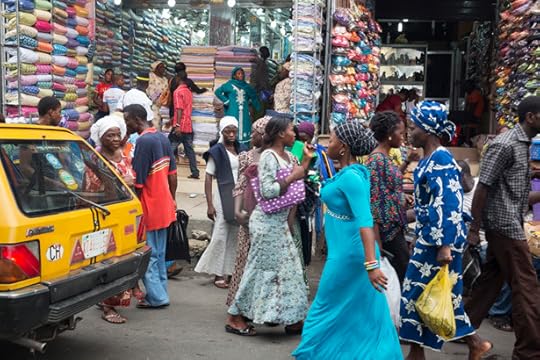
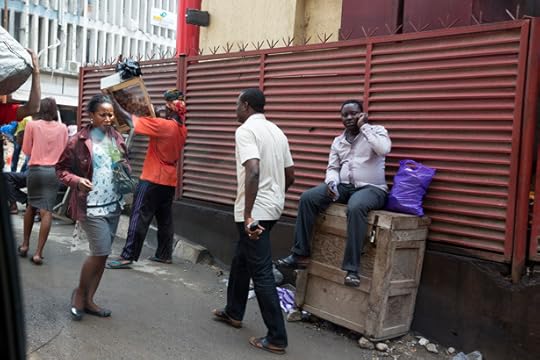
So I have decided to apply this forced situation to my advantage by indulging in a new form (well at least for me) of street photography. This is hybrid of the now famous google street view genre, where in the comfort of your own living room you can cruise your way round the streets, selecting those moments of revelation and the more traditional approach of beating the streets by foot with a camera. So as we crawl along the roads, I sit in my back seat shooting the scenes outside. As well as the obvious comfort, you have the added advantage of not being seen so clearly as being out there on the road. The moment you are spotted on the street, everyone is alerted to you presence and the reactions range from, give me some cash, you can’t do this or even heavier threats) to abundant laughter, none of which help the street photo, as being spotted is normally the kiss of death.
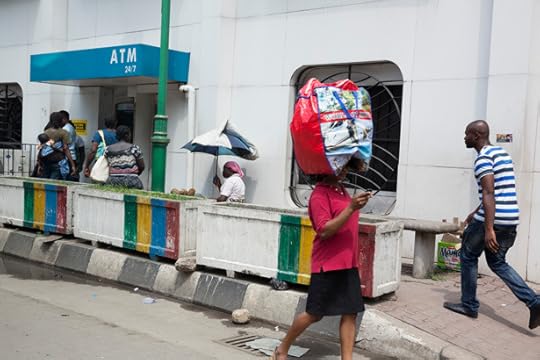

Having established this as a shooting mode, I now encourage my driver to go as near to the action as possible, and even when the streets are clear, to slow right down. Sometimes, when the window is heavily tinted, I have to have the window open, but the basic concept is the same, as the hustle of the Lagos pavement (if you are lucky) reveal their moments.
Before I arrived to Lagos, I had it in mind to shoot another subject, but this just came so naturally as the right way to solve another photographic problem, and I love this unpredictability of photography, and how the circumstances can dictate the action required.

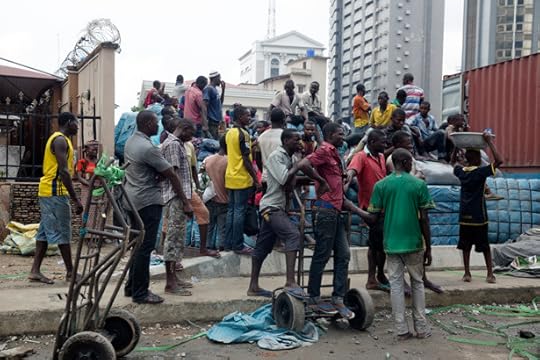
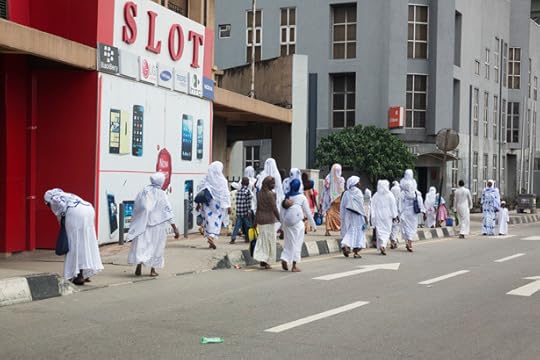
Martin Parr's Blog
- Martin Parr's profile
- 63 followers



